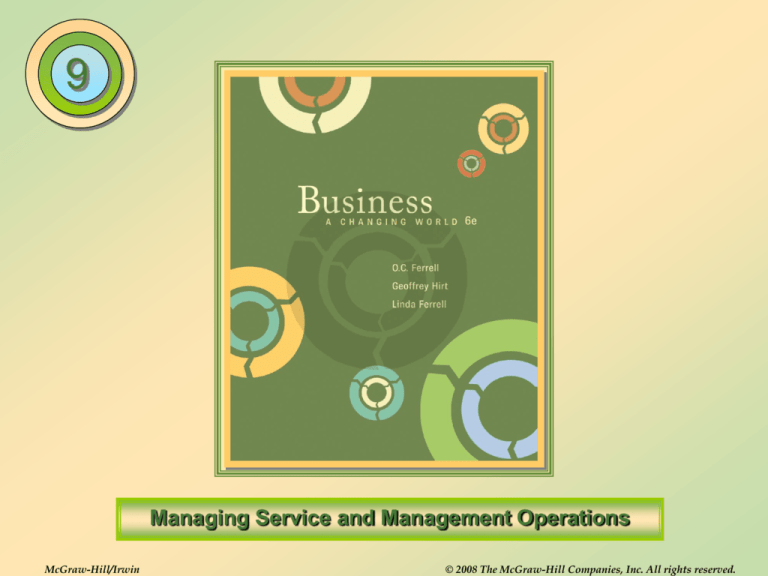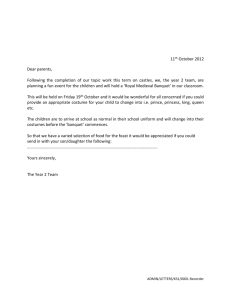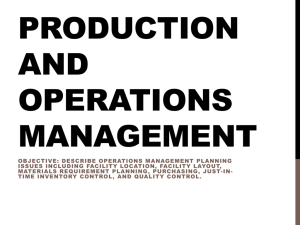
9
Managing Service and Management Operations
McGraw-Hill/Irwin
© 2008 The McGraw-Hill Companies, Inc. All rights reserved.
9-2
The Nature of Operations
Management (OM)
• The development and administration of the
activities involved in transforming
resources into goods and services
9-3
Key Operations Management
Terms
• Manufacturing
– The activities and processes used in making
tangible products; also called production
• Operations
– The activities and processes used in making
both tangible and intangible products
9-4
The Transformation Process
9-5
Inputs, Outputs, & Transformation Processes
in the Manufacture of Oak Furniture
9-6
Operations Management in Service
Businesses
• Service providers use human and mechanical
processes to provide products that are
intangible.
• The transformation process requires inputs such
as employees, equipment and supplies.
• Outputs provide a benefit from a performance,
event or type of involvement with the service
provider.
• Approximately 80% of the U.S. economy is
based on the service industry.
9-7
Different Types of
Transformation Processes
•
•
•
•
•
Nature and consumption of output
Uniformity of inputs
Uniformity of outputs
Labor required
Measurement of productivity
9-8
The Steps in Planning and
Designing Operations Systems
1. Planning the product
2. Designing the operations process
a. Standardization
b. Modular design
c. Customization
3. Planning capacity
Did You Know?
Hershey’s has the production capacity to make 33
million Hershey’s kisses per day or more than 12
billion per year.
9-9
The Steps in Planning and
Designing Operations Systems
4. Planning Facilities
– Facility Location
– Facility layout
•
•
•
•
Fixed-Position Layout
Project Organization
Process Layout (intermittent organizations)
Product Layout (continuous manufacturing
organization)
9-10
Facility Layouts
• Fixed-Position Layout--Project organization
– All resources needed for a product are brought to a
central location.
• Process Layout--Intermittent organization
– Layout is organized into departments that group
related processes.
• Product Layout--Continuous manufacturing
organization
– Production is broken down into relatively simple tasks
assigned to workers positioned along a line.
9-11
Technology
•
•
•
•
CAD (computer-assisted design)
CAM (computer-assisted manufacturing)
Flexible Manufacturing
CIM (computer-integrated manufacturing)
Did You Know?
Robotic Industries Association estimates
100,000 robots work in US factories, making
the US the world’s 2nd largest user of robots.
Source: Robotic Industries Association Website, “Robotics Industry Posts Second Best Year Ever,” from
http://robotics.org/public/articlesdetails.cfm?id=336 (accessed July 18, 2001).
9-12
Managing the Supply Chain
Purchasing Management
Inventory Control Management
Routing and Scheduling
Distribution Management
9-13
Purchasing
• Procurement
– Buying the right items
– Obtaining desired quality
– Buying the right quantity
– Paying the lowest price
– Obtaining inventory at the right time
9-14
Managing Inventory
• Three basic types of inventory:
– Finished-goods inventory
– Work-in-process inventory
– Raw materials inventory
9-15
Inventory Control Process
• Determines how many supplies and goods
are needed, and keeps track of:
– Quantities on hand
– Where each item is
– Who is responsible for it
Did You Know?
Scholastic, Inc., publisher of Harry Potter books
used JIT to deliver 100,000 copies of one book to
stores across the US just minutes before midnight on
July 8, the book’s official release date.
9-16
Inventory Management Approaches
• Economic order quantity model (EOQ)
– Identifies the optimum number of items to
order.
• Just in time inventory management (JIT)
– Uses smaller quantities of materials that
arrive “just in time.”
• Material-requirements planning (MRP)
– Schedules the precise quantity of materials
needed to make the product.
9-17
Routing and Scheduling
• Routing
– The sequence of operations through which a
product must pass
• Scheduling
– The assignment of required tasks to
departments or specific machines, workers, or
teams
– Program Evaluation and Review Technique
(PERT)
9-18
Hypothetical PERT Diagram for
Making a McDonald’s Big Mac
9-19
Managing Quality
• Quality Control
– The process an organization uses to maintain
its established quality standards.
•
•
•
•
Malcolm Baldrige National Quality Award
Total Quality Management (TQM)
Statistical Process Control
ISO 9000
9-20
Types and Percentages of Air
Travel Complaints in 2005
All other
Disability
25%
12%
6%
11%
11%
22%
13%
Customer service
Refunds
Reservations/
ticketing/ boarding
Baggage
Flight Problems
Source: Office of Aviation Enforcement and Proceedings, Air Travel Consumer
Report, February 2005, p. 39, available at http://airconsumer.ost.dot.
gov/reports/2005/0402atcr.pdf.
9-21
Malcolm Baldrige Quality Award
• The Baldrige criteria are:
– Leadership
– Information and analysis
– Strategic planning
– Human resource development and
management
– Process management
– Business results
– Customer focus and satisfaction
9-22
Total Quality Management (TQM)
• To regain a competitive edge, a number of
firms have adopted a total quality
management approach.
– Uniform commitment to quality in all areas of
the organization will promote a culture that
meets customers’ perceptions of quality.
9-23
Statistical Process Control
• A system in which management collects
and analyzes information about the
production process to pinpoint quality
problems in the production system.
9-24
Establishing Standards—ISO 9000
• Designed to ensure consistent product
quality under many conditions
• Provides a framework for documenting
how a certified business keeps records,
trains employees, tests products, and fixes
defects
– Inspection
– Sampling
9-25
Inspection
• Purchased items and finished items
– To determine what the quality level is
• Work-in-process
– To find defects before the product is
completed so that necessary corrections can
be made
Did You Know?
Quality Pays! The annual median income
for a quality assurance/control manager is
$65,536.
9-26
Sampling
• Whether to inspect 100 percent of the
output or only part of it is related to
– The cost of the inspection process
– The destructiveness of the inspection process
– The potential cost of product flaws in terms of
human lives and safety
9-27
Solve the Dilemma
1. What mistake did McKing make in
approaching the introduction of pizza?
2. How could this product introduction have
been coordinated to avoid the problems
that were encountered?
3. If you were an executive at McKing, how
would you proceed with the introduction
of pizza into the restaurants?
9-28
Explore Your Career Options
• How can an
understanding of total
quality management
(TQM) or ISO 9000 series
certification assist in
developing a career?
9-29
Additional Discussion Questions
and Exercises
1. What is the purpose of inventory control?
2. PERT charts can show a sequence of
activities in days rather than seconds.
– Draw a PERT chart for the chairperson of a
banquet committee showing the most
efficient path for these projected events:
9-30
Additional Discussion
Questions and Exercises
January 5
Confirm banquet room reservation.
January 6
Publicize banquet.
January 19
Count number of banquet reservations; phone in total to
hotel.
January 20
Phone chairpersons of banquet decorating committee and
hospitality committee to review preparations for banquet.
January 27
Decorating committee places decorations on tables.
(2-4 p.m.) Hospitality committee prepares
registration table and banquet booklets.
January 27
Banquet (6 p.m.)
January 30
Send thank-you notes to all committee persons and
hotel staff.
9-31
Chapter 9 Quiz
1. An assembly line is an example of
a.
b.
c.
d.
a product layout
a process layout
a fixed-position layout
an intermittent organization
2. Which of the following identifies the optimum number of
items to order to minimize the cost of ordering them?
a.
b.
c.
d.
just-in-time (JIT)
material-requirements planning (MRP)
economic-order quantity model
program evaluation and review technique (PERT)
9-32
Chapter 9 Quiz
3. Which of the following characteristics is most typical of
a continuous manufacturing organization?
a.
b.
c.
d.
The firm manufactures customized products.
The firm has a low volume of production.
The firm has a relatively low unit cost of production.
The firm creates many different products with many different
characteristics.
4. Inspection is concerned with
a.
b.
c.
d.
standards of quality.
labor and energy.
routing and scheduling.
modular design and customization.
9-33
Multiple Choice Questions
about the Video
1.
New Belgium Brewing Company uses what type of
power at its facility?
a.
b.
c.
d.
e.
2.
Wind
Steam
Solar
Hydroelectric
Pedal
New Belgium is planning to increase production from
____ to ____ barrels per year.
a.
b.
c.
d.
e.
400,000 : 800,000
200,000 : 300,000
250,000 : 500,000
10,000 : 15,000
500,000 : 1,000,000
9-34




